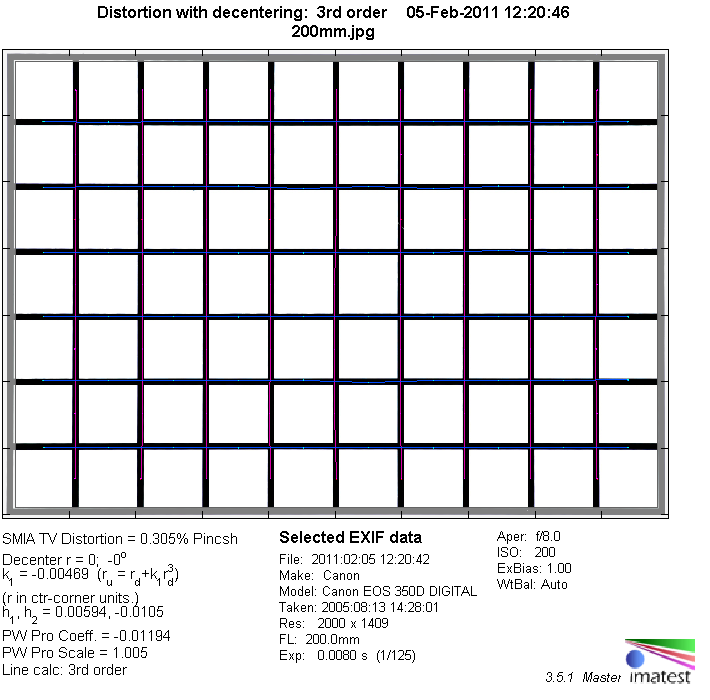|
Canon EF 200mm f/2.8 L USM II - APS-C Format Review / Lab Test Report - Analysis |
|
Lens Reviews -
Canon EOS (APS-C)
|
|
Page 2 of 2

Distortion
The Canon lens produces a very slight degree of pincushion distortion (0.3%). This is nothing to worry about in field-conditions.
200mm:

Vignetting
Full format lenses enjoy a sweet spot advantage when used on a crop format. The EF 200mm f/2.8 USM L II is fully usable at max. aperture with no significant light falloff. Starting at f/4 the vignetting is hardly detectable anymore even in lab conditions.

MTF (resolution)
The Canon lens is capable of delivering highly impressive results within the APS-C format scope. Both the center as well as border reach very good figures straight from f/2.8. The contrast level is also very punchy here. The quality is excellent if not outstanding between f/4 and f/8. There's no field curvature to speak of. The centering quality of the tested sample was very good.
Please note that the MTF results are not directly comparable across the different systems!
Below is a simplified summary of the formal findings. The chart shows line widths per picture height (LW/PH) which can be taken as a measure for sharpness.
If you want to know more about the MTF50 figures you may check out the corresponding Imatest Explanations
Chromatic Aberrations (CAs)
Typical for most prime lenses lateral chromatic aberrations (color shadows at harsh contrast transitions) are
extremely low at a width of less than 0.4px at the image borders. This is not field-relevant anymore.

Bokeh
Prime lenses should be able to provide a pleasing bokeh (out-of-focus blur) in shallow depth-of-field applications such as e.g. portraits. At f/2.8 the Canon lens is capable of producing circular out-of-focus highlights across the APS-C image frame. The aperture shape gets already visible at f/4 which is a side-effect of the non-rounded aperture blades - a dated aperture design. The inner highlight discs are smoothly rendered. The background- and foreground-blur is very smooth whereas the critical focus transition zones can be a little more nervous.


Bokeh Fringing / Longitudinal Chromatic Aberrations (LoCA)
Bokeh fringing is a color fringing effect in the focus transition zone showing a purple halo in front of the focus zone and a green one beyond. The 200mm f/2.8 USM L II has a rather typical characteristic here with a medium degree of LoCAs at f/2.8. The effect is mostly gone at f/4 and basically negligible at f/5.6.
|
Move the mouse cursor over the f-stop marks below to observe the respective LoCAs
|
| f/2.8 |
f/4 |
f/5.6 |
|

|
Verdict
The EF 200mm f/2.8 L USM II is very good within its native full format scope and when used on an APS-C DSLR things get even better. It provides a very high resolution combined with an excellent contrast straight from f/2.8. The lateral CAs are very low which contributes to the high sharpness perception. The global peak quality is reached between f/4-5.6. Vignetting is basically a non-issue on APS-C DSLRs. Typical for a prime lens the amount of pincushion distortion is not field-relevant. The quality of the bokeh is above average with a very smooth rending of the background- and foreground blur. On the downside out-of-focus highlights can get a little edgy from f/4 onwards. The mechanical execution is on a professional level – except for missing weather sealing. So the lens surely deserves our highest praise although it surely has a tough competition because the various Canon EF 70-200mm USM L variants match or exceed its quality or even better leaving only the comparatively compact size and low weight as differentiators.
|